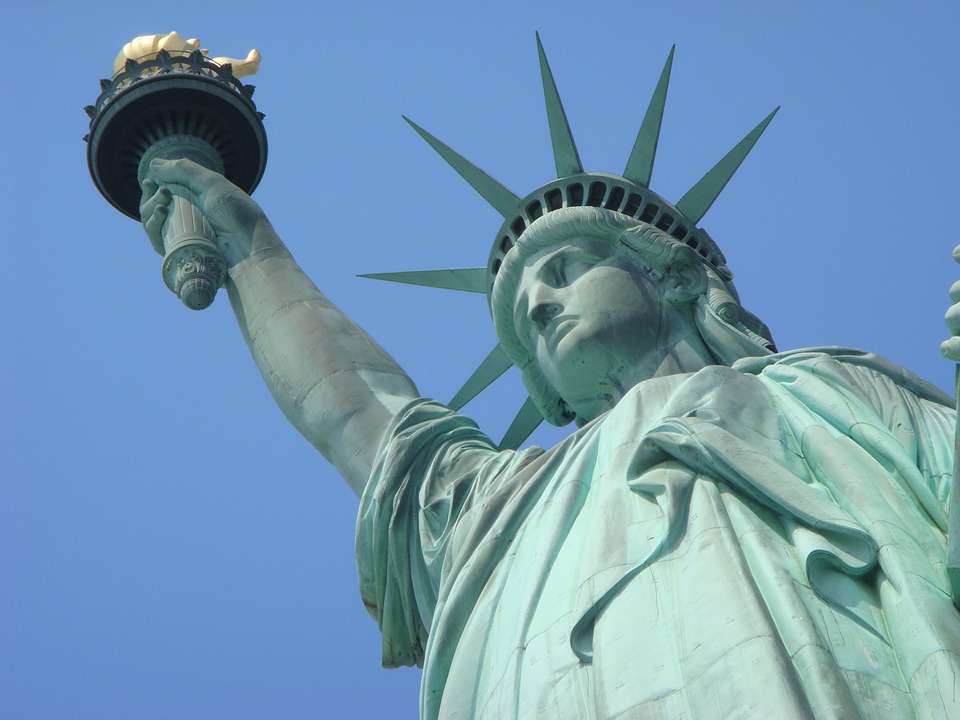On October 28, 1886, a 240-foot tall structure originally named “Liberty Enlightening the World” was revealed to an audience on Ellis Island in New York. This was the tallest structure in New York City, and it is still a great symbol in America today.1 Who would have known that a French sculptor and a French scholar would want to commemorate America for being a free nation for 100 years. These two individuals go by the names Frederic Auguste Bartholdi and Edouard-Rene Laboulaye.2 These two men met and created a sketch for the statue and wanted it to be a symbol of a “freedom-loving republic, a government in which power lay in the hands of the people, instead of a king.”3 The statue would also symbolize the alliance between France and America that began during the American War of Independence against Britain. There is a misconception that the statue was built to represent a welcoming icon for immigrants; however, this was not the initial purpose of the statue.4 France built the Statue of Liberty beginning in 1875. It was made out of 450,000 pounds of copper and steel. It was agreed by both nations that America was to be in charge of the pedestal, which weighed 27,000 tons, for the statue to rest on.5
In the construction of the statue, Bartholdi had used three hundred copper sheets to cover the entire statue. The reason why the statue appears to be green is due to its long exposure to the atmosphere over time. Something interesting is that the features of the statue’s face resemble those of Bartholdi’s mother and the arms resemble those of his wife. The Statue of Liberty is also presented wearing a long robe, which was influenced by ancient Greek and Rome attire. The purpose of this was to serve as a reminder of the ideals of that ancient era.6

The statue is carrying a tablet in her left hand with the year “1776” written on it, which is the year that Congress signed the Declaration of Independence. The significance behind this is to serve as a reminder that “all men are created equal.” It also reinforces the idea that if the government fails to abide by the natural rights of “life, liberty, and the pursuit of happiness,” then the citizens have the right to establish a new government by overthrowing the current one. This tablet also serves as a religious reminder of the Ten Commandments that Moses received when God revealed himself to him on Mount Sinai. The torch that is held in Liberty’s right hand symbolizes the light that the United States carries for the entire world. This suggests that nations should follow America’s political system, according to the French architects. She is also wearing a crown with sun rays beaming from it called a “diadem.” This refers to the ancient sun god, Helios.7
In 1884, the entire statue was done being constructed in France; however, due to its large size, it was packed into two hundred cases to be transported to New York.8 The place where the statue was assembled was Ellis Island. The statue is known as the “centerpiece of a magical American place,” since her popularity will grow through being imaged in magazines, newspapers, postcards, among other things.9 One issue with building the statue was the funding for the statue’s pedestal, since the U.S. government was not willing to pay for the construction of it. One way this was done was by fundraising and donations from various contributors, such as Joseph Pulitzer and Emma Lazarus. Pulitzer published in the New York World newspaper asking for donations for this statue. Lazarus wrote a poem at a fund-raising auction to help the funding of the statue’s pedestal.10
The unveiling of the statue was on a foggy, raining day on October 28, 1886. Millions of people witnessed this revelation and took part in a parade held in Manhattan. The President at the time was Grover Cleveland. He gave a speech at the ceremony about freedom and America’s democracy. However, immigration was not mentioned in this speech. The Statue of Liberty was the first major icon that immigrants would see as they came to America. The Statue of Liberty is an important icon in American history and is still a valued symbol today. The story behind its development and upbringing involved the interaction between France and the U.S. The purpose of the construction of this statue is to recognize America’s political system, its dependence on the ideals of freedom, and how America serves as a symbol of hope and a new start for immigrants.11
- Dictionary of American History, 2003, s.v. “Statue of Liberty,” by John Higham. ↵
- UXL Encyclopedia of U.S. History, 2009, s.v. “Statue of Liberty,” by Sonia Benson, Daniel E. Brannen, Jr., and Rebecca Valentine. ↵
- James L. Outman, Statue of Liberty In U.S. Immigration and Migration Reference Library (Detroit: UXL, 2004), 364. ↵
- James L. Outman, Statue of Liberty In U.S. Immigration and Migration Reference Library (Detroit: UXL, 2004), 364-365. ↵
- Dictionary of American History, 2003, s.v. “Statue of Liberty,” by John Higham. ↵
- James L. Outman, Statue of Liberty In U.S. Immigration and Migration Reference Library (Detroit: UXL, 2004), 366-367. ↵
- James L. Outman, Statue of Liberty In U.S. Immigration and Migration Reference Library (Detroit: UXL, 2004), 368-369. ↵
- James L. Outman, Statue of Liberty In U.S. Immigration and Migration Reference Library (Detroit: UXL, 2004), 369. ↵
- Dictionary of American History, 2003, s.v. “Statue of Liberty,” by John Higham. ↵
- James L. Outman, Statue of Liberty In U.S. Immigration and Migration Reference Library (Detroit: UXL, 2004), 365-370. ↵
- James L. Outman, Statue of Liberty In U.S. Immigration and Migration Reference Library (Detroit: UXL, 2004), 370-374. ↵



93 comments
Alexandria Martinez
This was a very informative article. I knew that the statue was not built or designed by the U.S. but I didn’t know all of the other details. I never knew what the meanings were for all of the little details such as the tablet, the crown and the gown. It was interesting to learn that the reason the statue is green is due to oxidation because my whole life I thought that the statue was just created or painted green, I never knew that it was copper.
Sergio Cervantes
Fantastic article over the history of one of America’s most iconic monuments to ever exist. It is nice to see that instead of constructing the statue in France where its designers were from, they decided to build it in a nation across the Atlantic. One can only imagine what it would be like to visit France and see the Statue of Liberty there. It is upsetting to read that the US government refused to fund the construction of this beautiful masterpiece on the shores of Ellis Island.
Mario De Leon
I really liked your featured image. Simple but I think the statue of liberty is very inspiring. I wonder if most people know that the statue of liberty was actually a gift from the French. It’s the perfect first thing to see if you were an immigrant to this country since it represent the power belongs to the people and not a king. I liked how you described what the statue is holding especially because I never knew.
Nelson Smithwick
Reading the article again was a great experience, The statue of liberty to this day is still a, if not the symbol of the United States as a new start for millions of immigrants. This article was very fun to read as the history of the statue is very interesting, especially the part about the statue actually being a gift from the french.
Alyssa Vela
I read this toward the beginning of the semester, and I thought it was really interesting then, but I think it’s even more interesting now! I still really liked how your article focused so much on how it was made, as well as the meaning behind it. There was a lot of detail put into it which meant you used a lot of scholarship. I can now understand why you were nominated for the “Best Use of Scholarship” category. Overall a great and informative article!
Briana Bustamante
Great Article! I find it incredible how the statue is a woman. My father is an architect so I’ve always found buildings fascinating. The way you’ve explained the significance of the statue of liberty was helpful. I love how the statue of liberty demonstrates the freedom that was promised to all. I can see why your article was nominated for best “Use of Scholarship”. You used a variety of scholars and it really shaped your article. Over all great job!
Lianna Ybarra
Now that I think about it, I think it’s very cool how the Statue of Liberty is a woman. I think that it symbolizes strength especially how it resembles one of the creators mother’s face and arms. If the Statue of Liberty is green because of the copper’s exposure to light and air, then what color did it originally plan to look like? You did an awesome job of doing plenty of research and scholarship for this article! Rereading it, I can definitely tell.
Erick Martinez
Great job on this article, I honestly had no idea the Statue of Liberty was 240 feet tall. You did a great job of researching to put this article together, and an even better job expressing all the information through your writing. The Statue of Liberty is very significant to our Nation in what it represents. I would love to one day see this beautiful monument in person.
Jennifer Pogue
This is a great article. I have always loved the Statue of Liberty and the story behind it. It seems like that was one of the last big pieces of art to be given from one country to another, as far as I know. The two men who created the statue were obviously extremely intelligent. To sketch an item then make it come to life on the other side of the world is unimaginable. The Statue of Liberty is one of my favorite monuments and I can not wait to go visit again.
Tyler Sleeter
Very informative article with lots of information. I was toured the Statue of Liberty and Ellis Island this summer and it was most impressive. Much of the information in your article was new to me even though I have been there. I had many of the misconceptions about the statue that you mention. I think this is due to the proximity to Ellis Island and to the poem associated with the statue about giving me your tired and your weak. I did not realize that there were so many symbols in the statue itself either. It is interesting to imagine what it must have been like for immigrants to see it on their way to Ellis Island.